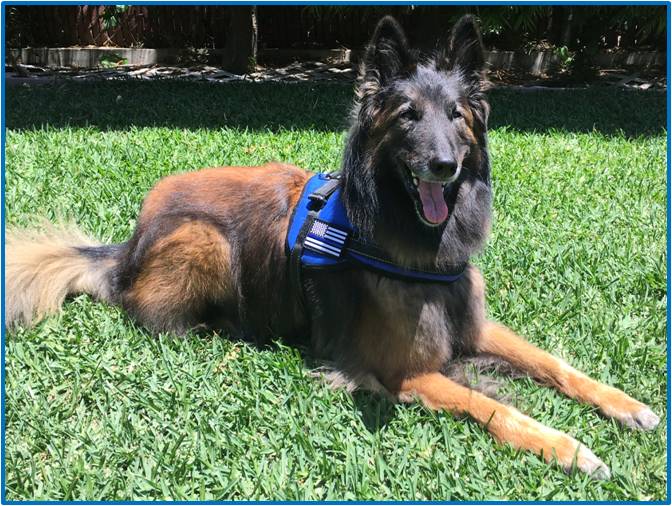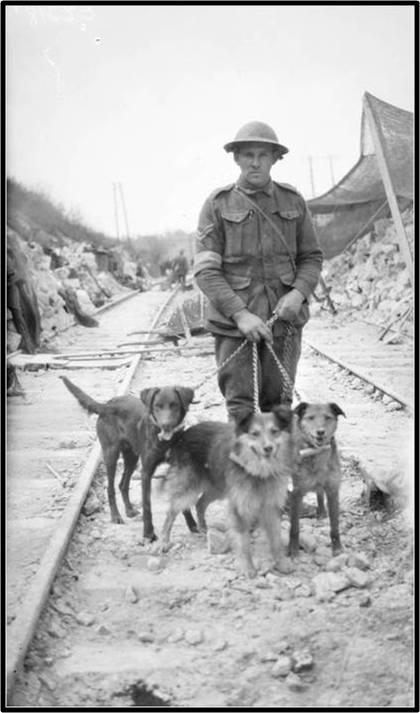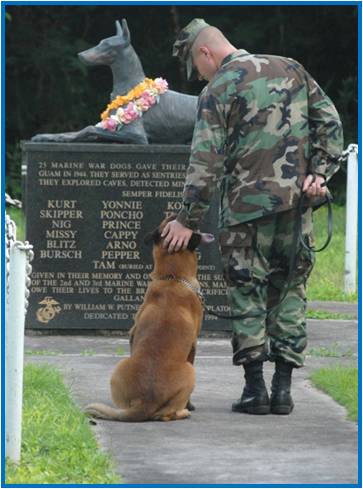Messenger Dog
Honoring our dogs, honoring our history
Background
Throughout human history, dogs have been by our sides and in our hearts, serving as both companion and help mate. They have tended our flocks and protected our homes, kept vermin at bay, and helped us hunt and procure food for our families. They have carried milk and medicine (and contraband), and have found those who are lost or in need of rescue on sea and on land. And they have played a pivotal role as messengers during times of war, allowing us to communicate with each other in an era before cell phones and personal devices.
Messenger Dogs in Europe: World War I
Thousands of dogs served as messengers during WWI. Any type of dog could and did serve, although traditional working breeds were among the most commonly selected for training.
The first officially recorded messenger dog was a Belgian Sheepdog, Taki, who made her way through treacherous terrain under heavy fire to deliver a coded message that saved the men in her unit. Taki faithfully served Allied troops for an additional four years until she was discharged, with honor, by the King of Belgium. She retired to live out her days in Long Beach, CA.
Messenger Dogs in the U.S: World War II
Although Allied forces had successfully used messenger dogs during WWI, it was not until World War II that the United States began to utilize dogs in earnest for military duties. In January of 1942, immediately following the attack on Pearl Harbor, a dedicated group of dog breeders, fanciers, and professional handlers established Dogs for Defense, Inc. With the support and endorsement of the American Kennel Club®, this new organization was able to provide all branches of the armed services with dogs and training funds.
The first five regional training centers were located in Virginia, Nebraska, Montana, California, and Mississippi. Through effective advertising across the country, Dogs for Defense was able to procure more than 20,000 dogs. Some came from breeders, some from shelters, and some were volunteered by their owners. Most of the 10,425 dogs who graduated from their military training classes were employed as sentries or scouts rather than as messengers. This was no doubt due in part to technological advancements in the area of communication, and also due to the fact that messenger work required a unique combination of abilities and skills that few dogs possessed:
Loyalty was the quality most desired in the messenger dog since he was motivated by the desire to please two masters between whom he carried messages. He also had to possess great speed, stamina, strength, endurance, ability to swim and superior powers of scenting and hearing. (Waller, 1958)
Not surprisingly, such dogs required specialized training and were in scarce supply. In fact, only 151 messenger dogs served during WWII. Their service was particularly invaluable in the South Pacific, with several receiving special recognition for their outstanding work.
Messenger Dogs Today
We no longer need dogs to serve as military messengers today. However, their unique abilities, innate intelligence, and enduring loyalty continue to make them invaluable in service, military, and police work (and, most importantly, as our faithful friends and companions).
The American Messenger Dog Association (AMDA) is proud to honor the service of these brave, faithful messenger dogs, many of whom gave their lives in carrying out their duties. Our goals are to (1) recognize the contributions that military messenger dogs made during WWI and WWII; (2) highlight the role that teamwork between dog and handler(s) plays in successful messenger work; and (3) allow current generations of dogs and their handlers to learn and to demonstrate these historically valuable skills.
We hope that participating in this program allows you and your dog to connect on a personal level with one incredible part of our shared history.

A Belgian Tervuren messenger dog.
Source: P. Regan (c) 2019
How Messenger Dog "Works"
Messenger Dog has four levels of performance and corresponding title achievement, each distinguished by a successively more challenging set of skills. To earn a title at a given level, the team must earn two "passing" scores (these may be under the same judge on the same day and/or at the same venue).
Messenger dogs were used to deliver important communications between groups (e.g., troops on the ground and command center). Thus, each messenger dog served two separate handlers - the sending handler (e.g., in command center) and the receiving handler (e.g., on the ground).
In order to maintain historical accuracy and allow the dog to demonstrate the ability to successfully deliver a message, each competing team consists of the dog and two separate handlers (one who sends the dog with a message and one who receives the message from the dog).
A complete and successful message delivery consists of two "legs:" (1) Handler A sending the dog to Handler B, and (2) Handler B sending the dog back to Handler A.
The specific performance requirements and general regulations, as well as the test forms, are available under the "Documents" tab).
Who Can Participate in Messenger Dog Tests?
Messenger Dog is an inclusive sport. Purebred and mixed breed dogs are eligible to participate. Blind, deaf, and differently abled dogs (including amputees and/or dogs who use mobility carts) are encouraged to participate. Remember that messenger dogs frequently had to work under conditions in which hearing and seeing were difficult; they had to rely on their handler's signals, their own sense of smell and direction, their previous training, and their courage. Any dog able to move with or without mechanical assistance and able to respond to the handler's signals and/or commands may participate in the sport of Messenger Dog.
Bitches in season may participate in Messenger Dog tests; however, they must compete after all other teams have competed.
Who Can Judge Messenger Dog Tests?
Any person who is licensed to judge any canine performance event (including Canine Good Citizen® tests) by any national dog sport organization (e.g., American Kennel Club®, United Kennel Club®, Australian Shepherd Club of America®, Do More With Your Dog!®, National Association of Canine Scent Work®, USDAA, CPE, etc.) is eligible to judge Messenger Dog performances.
If an eligible judge is not available, two witnesses or one witness and a video submission to AMDA are acceptable. See title application form for submission criteria.

